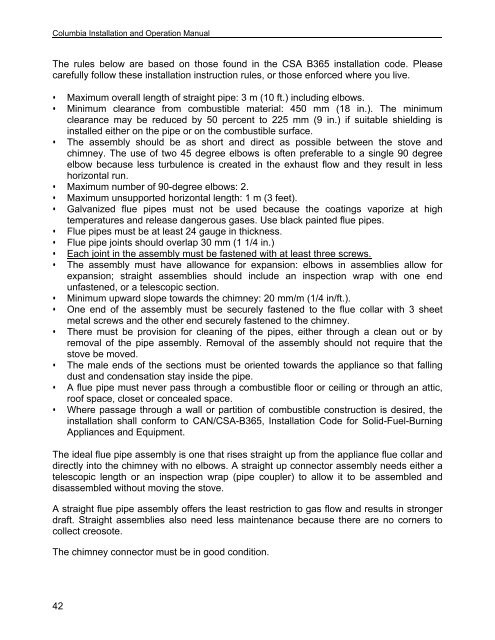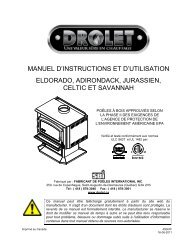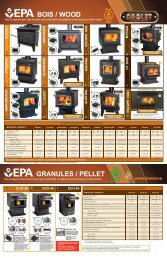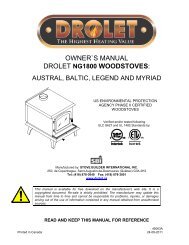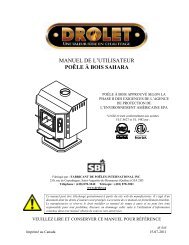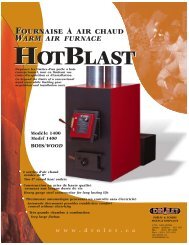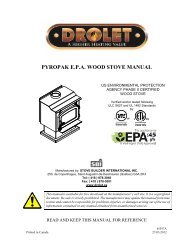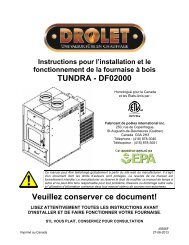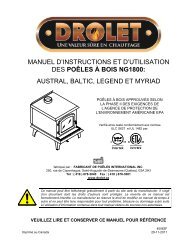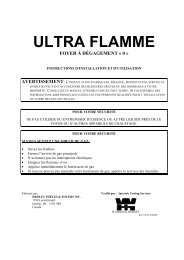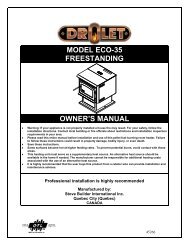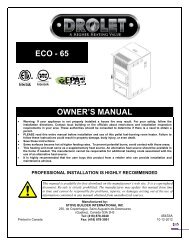You also want an ePaper? Increase the reach of your titles
YUMPU automatically turns print PDFs into web optimized ePapers that Google loves.
Columbia Installation and Operation ManualThe rules below are based on those found in <strong>the</strong> CSA B365 installation code. Pleasecarefully follow <strong>the</strong>se installation instruction rules, or those enforced where you live.• Maximum overall length of straight pipe: 3 m (10 ft.) including elbows.• Minimum clearance from combustible material: 450 mm (18 in.). The minimumclearance may be reduced by 50 percent to 225 mm (9 in.) if suitable shielding isinstalled ei<strong>the</strong>r on <strong>the</strong> pipe or on <strong>the</strong> combustible surface.• The assembly should be as short and direct as possible between <strong>the</strong> stove andchimney. The use of two 45 degree elbows is often preferable to a single 90 degreeelbow because less turbulence is created in <strong>the</strong> exhaust flow and <strong>the</strong>y result in lesshorizontal run.• Maximum number of 90-degree elbows: 2.• Maximum unsupported horizontal length: 1 m (3 feet).• Galvanized flue pipes must not be used because <strong>the</strong> coatings vaporize at hightemperatures and release dangerous gases. Use black painted flue pipes.• Flue pipes must be at least 24 gauge in thickness.• Flue pipe joints should overlap 30 mm (1 1/4 in.)• Each joint in <strong>the</strong> assembly must be fastened with at least three screws.• The assembly must have allowance for expansion: elbows in assemblies allow forexpansion; straight assemblies should include an inspection wrap with one endunfastened, or a telescopic section.• Minimum upward slope towards <strong>the</strong> chimney: 20 mm/m (1/4 in/ft.).• One end of <strong>the</strong> assembly must be securely fastened to <strong>the</strong> flue collar with 3 sheetmetal screws and <strong>the</strong> o<strong>the</strong>r end securely fastened to <strong>the</strong> chimney.• There must be provision for cleaning of <strong>the</strong> pipes, ei<strong>the</strong>r through a clean out or byremoval of <strong>the</strong> pipe assembly. Removal of <strong>the</strong> assembly should not require that <strong>the</strong>stove be moved.• The male ends of <strong>the</strong> sections must be oriented towards <strong>the</strong> appliance so that fallingdust and condensation stay inside <strong>the</strong> pipe.• A flue pipe must never pass through a combustible floor or ceiling or through an attic,roof space, closet or concealed space.• Where passage through a wall or partition of combustible construction is desired, <strong>the</strong>installation shall conform to CAN/CSA-B365, Installation Code for Solid-Fuel-BurningAppliances and Equipment.The ideal flue pipe assembly is one that rises straight up from <strong>the</strong> appliance flue collar anddirectly into <strong>the</strong> chimney with no elbows. A straight up connector assembly needs ei<strong>the</strong>r atelescopic length or an inspection wrap (pipe coupler) to allow it to be assembled anddisassembled without moving <strong>the</strong> stove.A straight flue pipe assembly offers <strong>the</strong> least restriction to gas flow and results in strongerdraft. Straight assemblies also need less maintenance because <strong>the</strong>re are no corners tocollect creosote.The chimney connector must be in good condition.42


